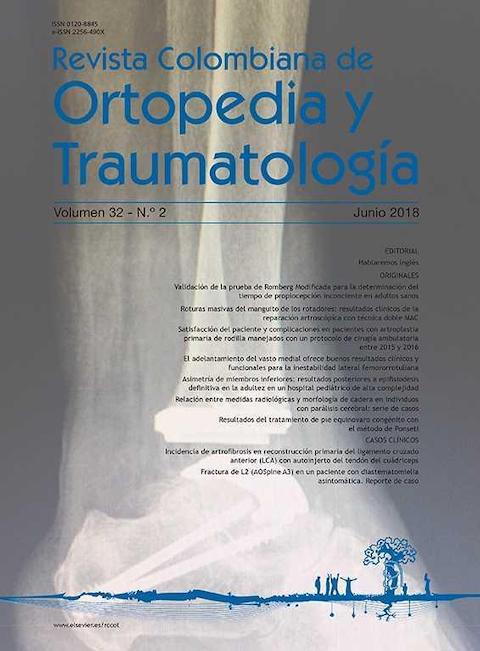Resultados del tratamiento de pie equinovaro congénito con el método de Ponseti
DOI:
https://doi.org/10.1016/j.rccot.2017.09.003Palabras clave:
Ponseti, pie equinovaro, recidivaResumen
Introducción: El pie equinovaro congénito es la deformidad congénita más frecuente del pie. Actualmente, el método Ponseti es el método de referencia para el tratamiento de esta anomalía, pues provee de una corrección completa de las deformidades con buena movilidad y función del pie. Existen muchos estudios en el mundo que muestran resultados funcionales del método. Sin embargo, en Colombia no hay publicaciones de este tipo con el método Ponseti.
Materiales y métodos: Este es un estudio descriptivo, retrospectivo, de tipo serie de casos en pacientes entre 0 y 12 años diagnosticados con pie equinovaro congénito, tratados con el método Ponseti entre julio de 2002 y diciembre de 2015. Con un seguimiento mínimo de menos 6 meses, se midió la gravedad según la escala de Dimeglio y la funcionalidad según la escala de Laaveg-Ponseti.
Resultados: 123 pacientes (183 pies) con un seguimiento medio de 8 anos. ˜ Edad de inicio del tratamiento: entre 0 y 24 meses. Según la clasificación del grado de gravedad de Dimeglio, el 6,5% eran leves, el 74% moderados, el 13% graves y el 6,5%, muy graves. La mayoría de los pies estudiados era de origen idiopático (96%). El 20% presentaron recidiva. Los resultados funcionales según la escala de Laaveg-Ponseti fueron excelentes (71%), buenos (23%) o regulares (6%).
Discusión: Nuestros resultados con desenlaces buenos y excelentes del 94% son similares a reportes previos. Con una recidiva del 17,8%, en la bibliografía se reportan el 20 y el 40%, respectivamente. Este estudio, a diferencia de los demás, no encontró relación directa entre el uso del aparato de abducción y la recidiva. No hubo sobrecorrecciones y ningún paciente tuvo un resultado malo según la escala de Laaveg-Ponseti.
Nivel de evidencia clínica: Nivel IV.
Descargas
Referencias bibliográficas
Tachdjian's Pediatric Orthopaedics, 3 rd edition. Volume 2. Philadelphia: WB Saunders; 2002. p. 922-58.
Morrissy, Weinstein. Lovell and Winter's Pediatric Orthopaedics. 6 th edition Philadelphia: Lippincott Williams and Wilkins; 2006. p. 1262-77.
Turco V. Clubfoot. Current problems in Orthopaedics. New York: Churchill Livingstone; 1981.
Rosselli P, Duplat J, Uribe I, Turriago C. Ortopedia infantil. Bogotá: Panamericana; 2005. p. 68.
Staheli Lynn T. Ortopedia pediátrica. Madrid: Marbán; 2006. p. 102-5.
Bohm M. The embryologic origin of clubfoot. J Bone Joint Surg. 1929;(11A):229.
Fukujara K, Schollmeier G, Uhthoff HK. The pathogenesis of clubfoot: a histomorphometric and immunohistochemical study of fetuses. J Bone Joint Surg. 1994;(76B):450. https://doi.org/10.1302/0301-620X.76B3.8175852
Zimny Ml, Willing SJ, Roberts JM, D'Ambrosia RD. An electron microscopic study of the fascia from the medial and lateral sides of clubfoot. J Pediatr Orthop. 1985;5:577. https://doi.org/10.1097/01241398-198509000-00014
Dimeo AJ Sr, Lalush DS, Grant E, Morcuende JA. Development of a surrogate biomodel for the investigation of clubfoot bracing. J Pediatr Orthop. 2012;32:e47-52. https://doi.org/10.1097/BPO.0b013e3182571656
Forriol Campos F. Manual de cirugía ortopédica y traumatología. 2.a edición Madrid: Panamericana; 2009. p. 1441-4. https://doi.org/10.1016/S1888-4415(10)70002-3
Herzenberg JE, Radler C, Bor N. Ponseti versus traditional methods of casting for idiopathic clubfoot. J Pediatr Orthop. 2002;22:517-21. https://doi.org/10.1097/01241398-200207000-00019
Ponseti IV. Congenital clubfoot. Fundamentals of treatment. Oxford: Oxford University Press; 1996.
Cooper DM, Dietz FR. Treatment of idiopathic clubfoot: a thirty year follow-up note. J Bone Joint Surg Am. 1995;77:1477-89. https://doi.org/10.2106/00004623-199510000-00002
Turco VJ. Resistant congenital club foot: One-stage posteromedial release with internal fixation. A follow-up report of a fifteen-year experience. J Bone Joint Surg Am. 1979;61:805-14. https://doi.org/10.2106/00004623-197961060-00002
Radler C, Mindler GT. Pediatric clubfoot: Treatment of recurrence. Orthopade. 2016;45:909-24. https://doi.org/10.1007/s00132-016-3319-9
Cooper DM, Dietz FR. Treatment of idiopathic clubfoot: a thirtyyear follow-up note. J Bone Joint Surg. 1995;(77A):1477. https://doi.org/10.2106/00004623-199510000-00002
Ponseti I. Clubfoot. Ponseti Management. Global health publication; 2003.
Ponseti I. Treatment of congenital club foot. J Bone Joint Surg. 1992;(74A):448. https://doi.org/10.2106/00004623-199274030-00021
Ponseti I. Congenital clubfoot. Fundamentals of treatment. Oxford: Oxford University Press; 1996.
Tachdjian MO. Congenital talipes equinovarus. En: Tachdjian MO, editor. Pediatric Orthopedics. 2nd edition Philadelphia: Saunders; 1990. p. 2517.
Willis RB, Al-Hunaishel M, Guerra L, Kontio K. What proportion of patients need extensive surgery after failure of the Ponseti technique for clubfoot? Clin Orthop Relat Res. 2009;467:1294-7. https://doi.org/10.1007/s11999-009-0707-z
Ippolito E, Farsetti P, Caterini R, Tudisco C. Long-term comparative results in patients with congenital clubfoot treated with two different protocols. J Bone Joint Surg Am. 2003;85:1286-94. https://doi.org/10.2106/00004623-200307000-00015
Morcuende JA, Dolan LA, Dietz FR, Ponseti IV. Radical reduction in the rate of extensive corrective surgery for clubfoot using the Ponseti method. Pediatrics. 2004;113:376-80. https://doi.org/10.1542/peds.113.2.376
Scher DM. The Ponseti method for treatment of congenital club foot. Curr Opin Pediatr. 2006;18:22-5.
Segev E, Keret D, Lokiec F, Yavor A, Wientroub S, Ezra E, et al. Early experience with the Ponseti method for the treatment of congenital idiopathic clubfoot. Isr Med Assoc J. 2005;7:307-10.
Bor N, Coplan JA, Herzenberg JE. Ponseti Treatment for idiopathic clubfoot minimum 5-year followup. Clin Orthop Relat Res. 2009;467:1263-70. https://doi.org/10.1007/s11999-008-0683-8
Ponseti IV. Treatment of the complex idiopathic clubfoot. Clin Orthop Relat Res. 2006;451:171-6. https://doi.org/10.1097/01.blo.0000224062.39990.48









